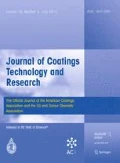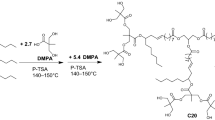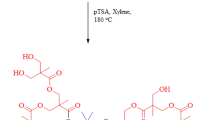Abstract
A hyperbranched polyester with carboxyl end group (HPC) was synthesized by using trimellitic anhydride and neopentyl glycol as raw materials via A2 + B3 polycondensation. Then, waterborne hyperbranched polyester acrylate (WHPC) was synthesized by partially modifying the carboxylic groups of HPC with glycidyl methacrylate. In order to explore the influence of molecular weight, acrylate groups content, and ion groups content on performances, a series of WHPC films with different molecular weight, acrylate groups content, and ion groups content were prepared. The dynamic light scattering spectrometer analysis shows that the higher ionic groups content and the lower molecular weight cause the smaller particle size. The ionic group content has a positive effect on the solubility. The smaller molecular weight and particle size cause the lower viscosity. The Fourier-transform IR spectrophotometer reveals that the double bond final conversion increased with increasing acrylate groups content. The final conversion is between 69 and 86%. The curing speed is fast, and the curing time is about 70 s due to the numerous end groups owned by the hyperbranched structure. The dynamic mechanical thermal analysis coupled with end-use mechanical property tests illustrates that the crosslink density has a positive effect on the storage modulus and a negative effect on the flexibility. It is also found that glass transition temperature and pencil hardness are determined by the balance between crosslink segment and hyperbranched polyester segment. The thermogravimetric analysis proves that increased crosslink density and molecular weight promote the heat resistance of films. This work utilizes a novel hyperbranched structure that excels in viscosity, flexibility, and water solubility. Furthermore, the preparation process is convenient.










Similar content being viewed by others
References
Wicks, Z, Jr, Jones, F, Peppas, S, Mujumdar, A, “Organic Coatings: Science and Technology. Volume 2: Applications, Properties, and Performance.” Drying Technol., 12 (7) 1771–1772 (1994)
Yan, R, Yang, D, Zhang, N, Zhao, Q, Liu, B, Xiang, W, Sun, Z, Xu, R, Zhang, M, Hu, W, “Performance of UV Curable Lignin Based Epoxy Acrylate Coatings.” Prog. Org. Coat., 116 83–89 (2018)
Gao, J, Zhu, FL, Yang, J, Liu, X, “Synthesis and Curing Kinetics of UV-Curable Waterborne Bisphenol-S Epoxy-Acrylate/Polyurethane-Acrylate/Methylacryloylpropyl-POSS Nanocomposites.” J. Macromol. Sci. Part B, 53 (12) 1800–1813 (2014)
Liu, R, Zhang, X, Zhu, J, Liu, X, Wang, Z, Yan, J, “UV-Curable Coatings from Multiarmed Cardanol-Based Acrylate Oligomers.” ACS Sustain. Chem. Eng., 3 (7) 1313–1320 (2015)
Wang, ZJ, Arceneaux, JA, Hall, J, “UV Curable Aqueous Dispersions for Wood Coatings.” Mod. Paint Coat. 86 (8) 24–28 (1996)
Stenson, P, “Radiation-Curable Water Borne Urethanes for the Wood Industry.” Mod. Paint Coat., 44 8 (1990)
Stenson, P, “New Developments in Water-Based UV/EB Curable Resins.” RadYech Rep., 7 (1) 18–23 (1993)
Delpech, MC, Coutinho, FM, “Waterborne Anionic Polyurethanes and Poly(Urethane-Urea)s: Influence of the Chain Extender on Mechanical and Adhesive Properties.” Polym. Test., 19 (8) 939–952 (2000)
Padget, J, “Polymers for Water-Based Coatings—A Systematic Overview.” JCT J. Coat. Technol., 66 (839) 89–105 (1994)
Voit, BI, Lederer, A, “Hyperbranched and Highly Branched Polymer Architectures—Synthetic Strategies and Major Characterization Aspects.” Chem. Rev., 109 (11) 5924–5973 (2009)
Yates, C, Hayes, W, “Synthesis and Applications of Hyperbranched Polymers.” Eur. Polym. J., 40 (7) 1257–1281 (2004)
Dong, H, Dai, Y, Zhang, X, Zhang, Z, Fu, S, Zhong, Z, “The Influence of Amine Structures on the Stability and Catalytic Activity of Gold Nanoparticles Stabilized by Amine-Modified Hyperbranched Polymers.” Nanotechnology, 29 (5) 055705 (2018)
Sendijarevic, I, McHugh, AJ, “Effects of Molecular Variables and Architecture on the Rheological Behavior of Dendritic Polymers.” Macromolecules, 33 (2) 590–596 (2000)
Asif, A, Huang, C, Shi, W, “Structure–Property Study of Waterborne, Polyurethane Acrylate Dispersions Based on Hyperbranched Aliphatic Polyester for UV-Curable Coatings.” Colloid Polym. Sci., 283 (2) 200–208 (2004)
Xiang, H, Wang, X, Xi, L, Dong, H, Hong, P, Su, J, Cui, Y, Liu, X, “Effect of Soft Chain Length and Generation Number on Properties of Flexible Hyperbranched Polyurethane Acrylate and Its UV-Cured Film.” Prog. Org. Coat., 114 216–222 (2018)
Paul, T, Presser, JP, Payandeh, S, Wolf, MH, Worgt, S, Gioia, J, “Fast Curing UV Inkjet Inks Based on Hyper-Branched Polyester Acrylates.” US Patent 20170283631 (2017)
Follmann, HD, Oliveira, ON, Lazarin-Bidóia, D, Nakamura, CV, Huang, X, Asefa, T, Silva, R, “Multifunctional Hybrid Aerogels: Hyperbranched Polymer-Trapped Mesoporous Silica Nanoparticles for Sustained and Prolonged Drug Release.” Nanoscale, 10 (4) 1704–1715 (2018)
Xu, LQ, Yee, YK, Neoh, K-G, Kang, E-T, Fu, GD, “Cyclodextrin-Functionalized Graphene Nanosheets, and Their Host-Guest Polymer Nanohybrids.” Polymer, 54 (9) 2264–2271 (2013)
Wen, G-A, Xin, Y, Zhu, X-R, Zeng, W-J, Zhu, R, Feng, J-C, Cao, Y, Zhao, L, Wang, L-H, Wei, W, “Hyperbranched Triazine-Containing Polyfluorenes: Efficient Blue Emitters for Polymer Light-Emitting Diodes (PLEDs).” Polymer, 48 (7) 1824–1829 (2007)
Yu, D, Ni, H, Wang, L, Wu, M, Yang, X, “Nanoscale-Confined Precursor of CuFe2O4 Mediated by Hyperbranched Polyamide as an Unusual Heterogeneous Fenton Catalyst for Efficient Dye Degradation.” J. Clean. Prod., 186 146–154 (2018)
Asif, A, Huang, C, Shi, W, “UV Curing Behaviors and Hydrophilic Characteristics of UV Curable Waterborne Hyperbranched Aliphatic Polyesters.” Polym. Adv. Technol., 14 (9) 609–615 (2003)
Lin, X, Zhang, S, Qian, J, “Synthesis and Properties of a Novel UV-Curable Waterborne Hyperbranched Polyurethane.” J. Coat. Technol. Res., 11 (3) 319–328 (2013)
Asif, A, Shi, W, Shen, X, Nie, K, “Physical and Thermal Properties of UV Curable Waterborne Polyurethane Dispersions Incorporating Hyperbranched Aliphatic Polyester of Varying Generation Number.” Polymer, 46 (24) 11066–11078 (2005)
Asif, A, Shi, W, “Synthesis and Properties of UV Curable Waterborne Hyperbranched Aliphatic Polyester.” Eur. Polym. J., 39 (5) 933–938 (2003)
Wei, D, Liao, B, Yong, Q, Wang, H, Li, T, Huang, J, Pang, H, “Castor Oil-Based Waterborne Hyperbranched Polyurethane Acrylate Emulsion for UV-Curable Coatings with Excellent Chemical Resistance and High Hardness.” J. Coat. Technol. Res., 16 (2) 415–428 (2018)
Fu, J, Yu, H, Wang, L, Lin, L, Khan, RU, “Preparation and Properties of UV-Curable Hyperbranched Polyurethane Acrylate Hard Coatings.” Prog. Org. Coat., 144 105635 (2020)
Yin, W, Zeng, X, Li, H, Hou, Y, Gao, Q, “Synthesis, Photopolymerization Kinetics, and Thermal Properties of UV-Curable Waterborne Hyperbranched Polyurethane Acrylate Dispersions.” J. Coat. Technol. Res., 8 (5) 577 (2011)
Hawker, C, Lee, R, Fréchet, J, “One-Step Synthesis of Hyperbranched Dendritic Polyesters.” J. Am. Chem. Soc., 113 (12) 4583–4588 (1991)
Jovičić, M, Radičević, R, Pavličević, J, Bera, O, Govedarica, D, “Synthesis and Characterization of Ricinoleic Acid Based Hyperbranched Alkyds for Coating Application.” Prog. Org. Coat., 148 105832 (2020)
Zhang, S, Chen, J, Han, D, Feng, Y, Shen, C, Chang, C, Song, Z, Zhao, J, “Effect of Polyether Soft Segments on Structure and Properties of Waterborne UV-Curable Polyurethane Nanocomposites.” J. Coat. Technol. Res., 12 (3) 563–569 (2015)
Boton, LB, Puguan, JMC, Latif, M, Kim, H, “Synthesis and Properties of Quick-Drying UV-Curable Hyperbranched Waterborne Polyurethane Coating.” Prog. Org. Coat., 125 201–206 (2018)
Chen, Y, Chen, Y-L, “Aqueous Dispersions of Polyurethane Anionomers: Effects of Countercation.” J. Appl. Polym. Sci., 46 (3) 435–443 (1992)
Decker, C, “Photoinitiated Crosslinking Polymerisation.” Prog. Polym. Sci., 21 (4) 593–650 (1996)
Zhang, J, Xu, H, Hu, L, Yang, Y, Li, H, Huang, C, Liu, X, “Novel Waterborne UV-Curable Hyperbranched Polyurethane Acrylate/Silica with Good Printability and Rheological Properties Applicable to Flexographic Ink.” ACS Omega, 2 (11) 7546–7558 (2017)
Džunuzović, ES, Tasic, S, Bozic, B, Babić, D, Dunjic, B, “Dynamical Mechanical Analysis of Photocrosslinked Hyperbranched Urethane Acrylates.” J. Serb. Chem. Soc., 69 (6) 441–453 (2004)
Hill, LW, “Calculation of Crosslink Density in Short Chain Networks.” Prog. Org. Coat., 31 (3) 235–243 (1997)
Zhang, Q, Huang, C, Wang, H, Hu, M, Li, H, Liu, X, “UV-Curable Coating Crosslinked by a Novel Hyperbranched Polyurethane Acrylate with Excellent Mechanical Properties and Hardness.” RSC Adv., 6 (109) 107942–107950 (2016)
Acknowledgments
This work was supported by the National Natural Science Foundation of China (51873042), the Science and Technology Planning Project of Guangdong Province (2017B090915004), and the Guangdong Provincial Key Laboratories (2017B030314105).
Author information
Authors and Affiliations
Corresponding author
Additional information
Publisher's Note
Springer Nature remains neutral with regard to jurisdictional claims in published maps and institutional affiliations.
Rights and permissions
About this article
Cite this article
Liu, J., Wang, S., Su, Q. et al. Synthesis of a novel hyperbranched polyester with carboxyl end groups applied to UV-curable waterborne coating. J Coat Technol Res 18, 259–269 (2021). https://doi.org/10.1007/s11998-020-00404-6
Published:
Issue Date:
DOI: https://doi.org/10.1007/s11998-020-00404-6




